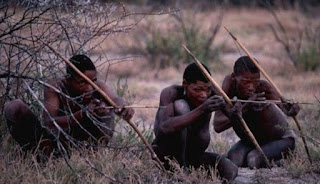IT-FLEXIBLE_The
team of scientists from Nanyang Technological University (NTU
Singapore) and Penn State University in the US has managed to find one
of the oldest lineages in modern humans through gene sequence Khoisan. Khoisan is a unifying name for the two groups of South African
society, this population has physical and linguistic characteristics of
the allegedly different from Bantu culture.
According
to Professor Christoph Stephan Schuster, this finding is the first
mention of the history of human populations are analyzed and adjusted to
the earth's climate over the past 200,000 years. The
study results are published in the journal Nature Communications
edition December 4, 2014. The project involves six researchers NTU and
Penn State University. Other participating institutions include Ohio State University and the Sao Paulo State University, Brazil. Prof. Schuster will continue to seek and find more non-genetic mixture
of the other located in the region, such as in South America and South
Asia (including Indonesia) where the indigenous people there
Scientists
sort genome taken from five tribes of hunter-gatherers who lived in
South Africa, and compared with 1462 420,000 genetic variants in the
genome derived from 48 global ethnic groups. By using sophisticated analytical calculations, a team of
scientists found that the Khoisan tribe in South Africa are genetically
different, not only from Europe and Asia, but also from all other
African people.
Geneticists
also discovered the presence of individuals in which the Khoisan tribe
of their fathers do not interbreed with one of the other ethnic groups
during the past 150,000 years. Khoisan constituted the majority of which live in the time period around 20,000 years ago. This analysis used genetic sequencing to reveal the ancestral lineage of each ethnic group, even up to 200,000 years ago. If the individual is found non mixtures such as Khoisan case, this
will show evidence of genetic changes important for the descendants of
their ancestors, because of interbreeding or migration occurred for
centuries.
Khoisan group, the hunters and gatherers in South Africa has always regarded itself as the oldest person. This study proves that they belong to one of the most ancient in the human lineage. And a high-quality genome sequence will help scientists better understand the history of the human population. New data gathered enables scientists to better understand how the
human genome evolved and create more effective treatments for certain
genetic diseases.
Of
the five tribes which is the oldest member of the tribe Ju / 'hoansi
and other tribes that lived in the sea area of Namibia, two people
have genomes that are not mixed with other ethnic groups. Tribe Ju / 'hoansi famous since the movie "The Gods Must Be Crazy' in the 80s and 90s. According
to Dr Lim Kim Hie, that this group does not seem to mate with the
neighboring non-Khoisan tribes for thousands of years. Because people Khoisan and modern humans lived alongside their ancestor about 150,000 years ago.
In
the Khoisan ethnic culture and traditions, so long cross-breeding
occurs among groups of Khoisan or the marriage of women who leave their
tribe once married to non-Khoisan. Even
after 150,000 years, non-mixed single individuals or their descendants
who do not interbreed with separate populations can be identified in the
population Ju / 'hoansi.

0 komentar:
Post a Comment